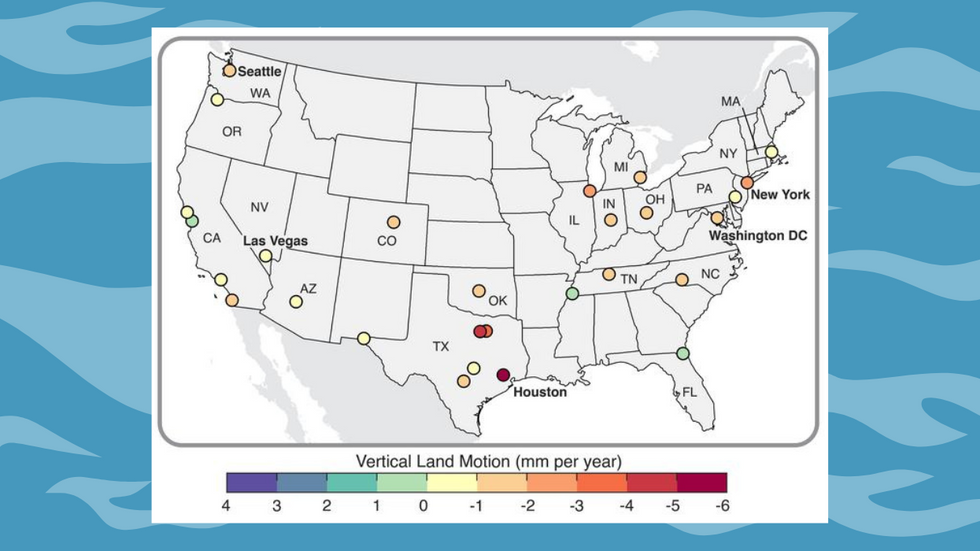Is your city drowning? You could be one of roughly 34 million Americans whose hometowns are sinking into Earth’s abyss, according to a new report published in the journal Nature Cities. The increased rate of land subsidence (AKA, sinking land) poses a “slow-moving hazard” on inland urban areas and structural damage nationwide. Keep reading to find out if your city is part of the problem.
RELATED: Meteorologists Predict Wildfires Will Burn 9 Million Acres of Land This Year—Is Your Region at Risk?
The study identified 28 major U.S. cities—ranging from Seattle to Dallas to New York—that are actively sinking. Researchers used satellite-based radar measurements to analyze the rate of subsidence underneath our nation’s most densely populated cities.
Findings show that at least 20 percent of urban areas are sinking in all 28 cities listed. However, in 25 of those cities, at least 65 percent of the area is sinking. Additionally, more than 29,000 structures are located in “high and very high damage risk areas, indicating a greater likelihood of infrastructure damage.”
Researchers believe “massive ongoing groundwater extraction” is to blame. Downward shifts in land can threaten “the structural integrity” of buildings, roads, bridges, and dams. Leonard Ohenhen, a postdoctoral researcher at the Columbia Climate School’s Lamont-Doherty Earth Observatory and lead study author, said this literal downward trend can “profoundly impact” infrastructure risks.
“A lot of small changes will build up over time, magnifying weak spots within urban systems and heighten flood risks,” Ohenhen said in a news release.
“The latent nature of this risk means that infrastructure can be silently compromised over time with damage only becoming evident when it is severe or potentially catastrophic,” added Manoochehr Shirzaei, PhD, study author and Virginia Tech associate professor. “This risk is often exacerbated in rapidly expanding urban centers.”
But some cities are sinking faster than others. Significant elevation loss was detected in New York, Seattle, Chicago, Denver, Las Vegas, Washington, D.C., Houston, Fort Worth, Dallas, and San Francisco. These areas are experiencing between two and five millimeters of subsidence annually.
RELATED: 40 Ocean Facts That Will Blow You Out of the Water.
Manhattan is a major area of concern—particularly the city’s LaGuardia airport in Queens, which is sinking five millimeters per year.
“New York City alone accounts for 26 percent of the total subsiding population with the other seven cities making up 5-8 percent of the population residing on subsiding land,” says the study.
However, the crown goes to Texas, whose three metropolises—Houston, Fort Worth, and Dallas—”exhibit the highest measured subsidence rates among all cities.” The trio has an average subsidence rate of four millimeters (at least) per year.
Conversely, three cities saw a gain in elevation. These included Memphis, Tennessee; San Jose, California; and Jacksonville, Florida.
In a news release, researchers said that “continued population growth and water usage combined with climate-induced droughts in some areas will likely worsen subsidence in the future.” However, there are also “natural forces” at play that could contribute to sinkage. One key example is flooding.
The good news is that subsidence can be slowed, and affected cities can take action steps to reduce their risk of subsidence-related catastrophes.
“In many places, flooding can be mitigated with land raising, enhanced drainage systems and green infrastructure such as artificial wetlands to absorb floodwaters. Cities susceptible to tilting hazards can focus on retrofitting existing structures, integrating land motions into building codes, and limiting new buildings in the areas of most threat,” says the release.
“As opposed to just saying it’s a problem, we can respond, address, mitigate, adapt,” Ohenhen added. “We have to move to solutions.”
Content shared from bestlifeonline.com.

